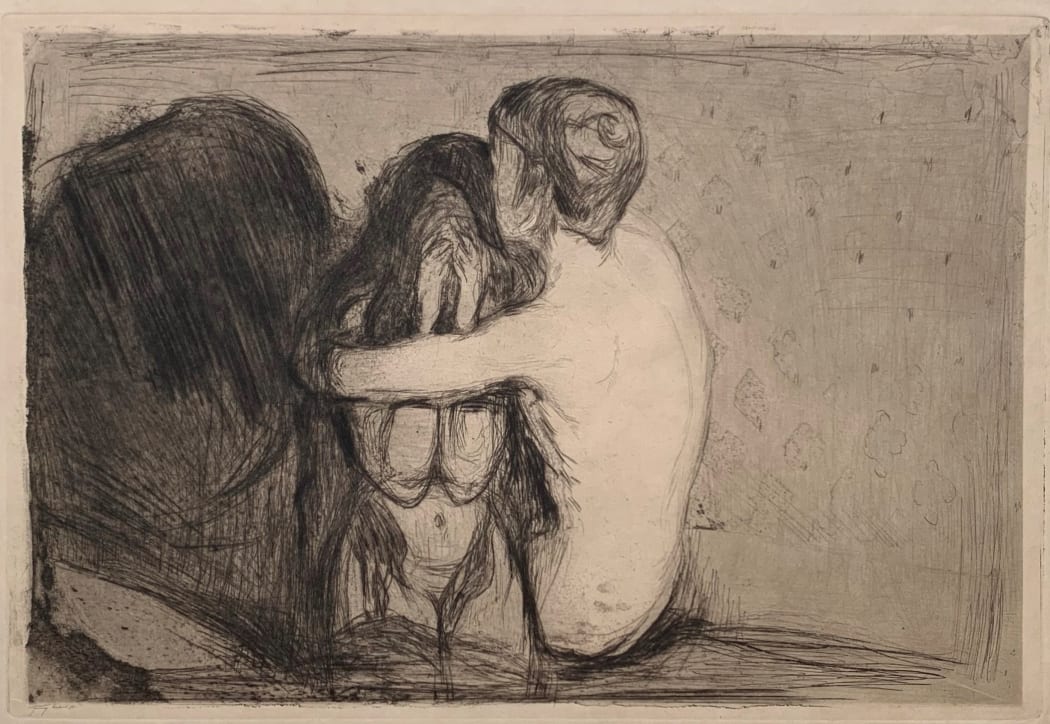
Today’s print takes on a simple but powerful theme: consolation. Though we are partially clued into this theme by the title, and last week we touched on Munch’s deprioritization of titles, the scene itself shows enough palpable sadness and comfort to support its name. The subjects of this print are a young couple in the midst of an intimate moment. The seated woman bends from the waist with her head in her hands as the man embraces her. They are both nude, although they are not exposed or sensualized in this image; along with the tight framing of the composition, this detail creates a sense of intimacy. The viewer is positioned like a fly on the wall, voyeuristically observing a private moment between two lovers where so much is unspoken.
Behind the distressed woman lurks a large imposing shadow, asserting itself as a member of this story. Both the man and the woman are faceless and we are left with their body language and the presence of the shadow to infer their moods. There is an ominous tone to this amorphous darkness lingering in the room. It appears like a ghost or monster, threatening to go bump in the night. Supernatural or not, the shadow embodies a fear of the unknown and heightens the despair otherwise present. Because of their positioning, it’s not clear if she is aware of this potential danger. The man, however, looks over her shoulder in the direction of the shadow. He is her source of comfort in this vulnerable moment but it’s unclear if he is also the reason for her sorrow.
The motif of intertwined or embracing lovers was often used by Munch. He had many tumultuous romantic relationships throughout his life and grew fascinated by the bond between lovers, which he saw as transcendent and described physical intimacy as “these two in that instant when they are no longer themselves, but only one link in the thousands of links that bind generations to one another.” * Does this “link” exist in other emotions besides euphoria? Can there be connection in sadness? Consolation (Woll 6) adds more dimension to this philosophy.
In most of Munch’s artistic depictions of lovers, they are either fused together, absorbed in this “link” he spoke of to the point where it is difficult to tell where one body begins and the other ends. Consolation is an example of the other main positioning Munch used to tell the story of romance as he experienced it. Though the couple is physically connected, there is an apparent emotional break evidenced by their body language. The woman sits forward with her lover facing the opposite direction. His arms wrap around her, while she turns inward. They are not (yet) separated but their contrasting positions and emotions suggest a rupture in their love. In this reading, the role of the shadow is an omen of a true and complete separation.
Munch met Milly Thaulow, his first great love, on vacation in Oslo in 1885. She was a prominent high society girl married to a captain but that didn’t stop a flirtation from blossoming. His personal journals detailed the tryst. Using pseudonyms, he spoke of “premonitions,” “[seeing] a new world” ** when they kissed for the first time, a Christian guilt about dabbling in adultery, and the thrill of eavesdropping. They parted after their short summer fling but he continued to explore his complicated feelings towards her for decades to come. Consolation was created 10 years after Munch’s affair with Milly but only two years prior to Separation, a painting about their parting ways. Even if a piece was not explicitly about Milly, their relationship impacted his view of love, sex, relationships, and women so intensely that her presence was felt in his life and work long after that fateful summer.
In the case of today’s print, we see the duality of pessimism and tenderness. Munch had many romances in his adulthood that sent him into horrible spirals of guilt and anxiety but he would somehow manage to find a way to fall in love again even if he had a creeping sense it could fall apart at any moment. He is both the crying woman falling forward as shadows encroach her vulnerable nude body and the man who faces the shadows despite his fear.
